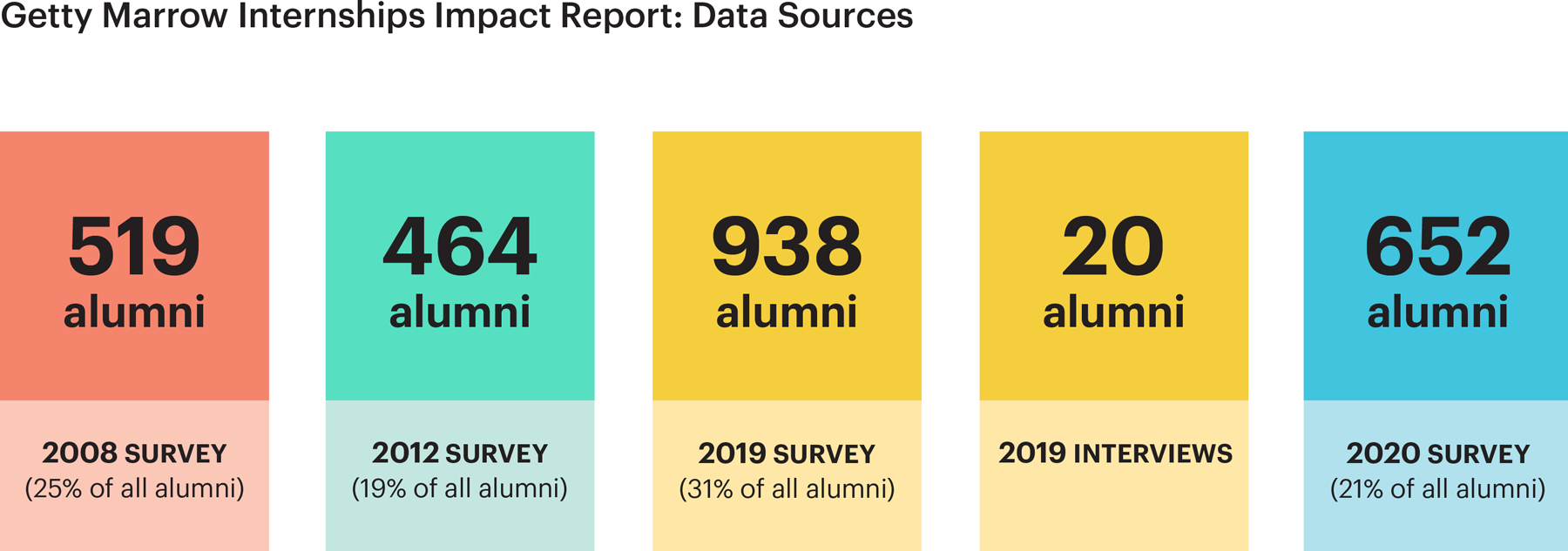Introduction
Los Angeles County is one of the most diverse places in the country, yet this racial and ethnic diversity is often not mirrored in the staff of museums and visual arts organizations. Individuals who contribute different perspectives and lived experiences to the workplace enrich the cultural relevance and value of arts organizations.
In an effort to encourage greater diversity in the professions related to museums and the visual arts, the Getty Marrow Undergraduate Internship program provides ten-week, full-time paid work opportunities for outstanding college undergraduates from backgrounds traditionally underrepresented in the arts, including but not limited to individuals of African American, Asian, Latino/Hispanic, Native American, or Pacific Islander descent.
The internships offer meaningful work experience in a variety of areas: communications, conservation, curatorship, digital projects, exhibitions/collections management, library collections/photo cataloguing, museum education, philanthropy, public programs, publications, and more. Participants also have the opportunity to grow their professional networks through programming that includes a dedicated career day (hosted at the Getty since 2009 as the annual Arts Summit) and Learning Communities that connect interns from different organizations with each other through site visits hosted by professionals working across the arts sector.
Since the program’s launch in 1993, 175 Los Angeles arts institutions, including Getty, have hosted over 3,200 interns, introducing more than 100 students each summer to career possibilities in the arts. The program has also inspired a public-private partnership between Getty and the Los Angeles County Department of Arts and Culture (formerly the Los Angeles County Arts Commission), which followed the Foundation’s lead in 2000 by starting a parallel program of undergraduate internships focused on the performing and literary arts. Together, this alliance forms the largest paid arts internship program in the country.
Report Purpose and Data Sources
The goals of this report are to document the internship program’s impact on participants (hereafter referred to as “alumni”) over time and present lessons learned that can help the Getty Foundation improve its program and benefit other organizations involved with diversifying the workforce of museums and visual arts organizations (hereafter referred to as “the arts”). The primary data sources of this report are three post-internship surveys sent to alumni over the past decade and a supplemental fourth survey that focused on the impact of COVID-19.1 The proportion of alumni responding across the three survey periods varies between 19% - 31%, with responses from the largest percentage of alumni occurring in 2019. Demographic data in the report results from participants self-identifying as belonging to a particular race or ethnicity; starting in 2007 students were able to identify as multi-racial and select more than one category.
As a follow-up to the 2019 survey, the Getty Foundation partnered with Engage R+D to conduct in-depth interviews2 of 20 alumni to learn more about their internships and the extent to which those internships have impacted their careers. Quotes from these interviews, plus data from external sources, are included throughout to give broader context. Responses were kept confidential to protect alumni’s identities and ensure honest feedback.
Notes
Given the wide-ranging effects of the COVID-19 pandemic, the Getty Foundation conducted a brief survey to assess the initial impact of the crisis on Getty Marrow alumni, particularly those working in the arts. This survey repeated questions from the 2008, 2012, and 2019 surveys to allow for comparisons over time. It is important to note that there were some differences in the way questions were asked across all of the surveys and, in some cases, the response options that were provided. There are also some instances where a question was asked in one year but not in others. For example, many new questions were introduced in the 2019 survey to gather additional information on undergraduate and postgraduate education. Key differences are noted throughout the report. ↩︎
The semi-structured, one-to-one phone interviews with alumni lasted one hour and took place in October and November 2019. The aim was to interview alumni that represent the broader pool to the extent possible in terms of gender, race/ethnicity, where they live (to compare those living in Los Angeles to those living outside of Los Angeles), the year they participated in the internship, and whether they were currently working in the arts. ↩︎
